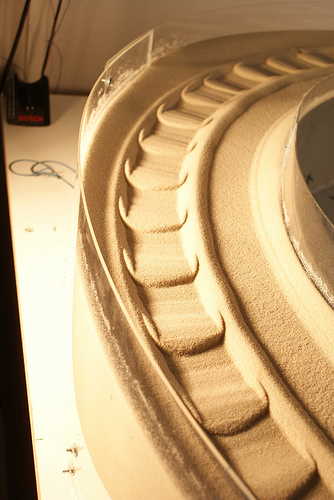Washboard Road
Baptiste Percier, Sébastien Manneville and Nicolas Taberlet
Collaboration : Jim McElwaine (University of Cambridge, United Kingdom) and Stephen Morris (University of Toronto, Canada).
 When an unpaved road is submitted to the repeated passages of vehicles, small ripples appear and grow bigger as vehicles pass. This phenomenon known as washboard road is as annoying for drivers as it is also dangerous because the adherence between the car and the road is reduced. We reproduced this instability both in experiments and DEM numerical simulations. In both cases, an object (which can be a rolling wheel, a blocked wheel, or a paddle) is dragged at a constant velocity over a circular track. No force is applied on the objet other than its weight and the reaction of the sand bed, there is no spring or dashpot. They all provide washboard as soon as the velocity of the object is above a critical velocity. Washboard roads have widely been studied and several explanations for this instability can be found in the litterature. Nevertheless all existing models for the washboard instability assume that the car suspension plays an important role, and these models does not predict washboard without a suspension although we know from our work that a suspension is not essential.
When an unpaved road is submitted to the repeated passages of vehicles, small ripples appear and grow bigger as vehicles pass. This phenomenon known as washboard road is as annoying for drivers as it is also dangerous because the adherence between the car and the road is reduced. We reproduced this instability both in experiments and DEM numerical simulations. In both cases, an object (which can be a rolling wheel, a blocked wheel, or a paddle) is dragged at a constant velocity over a circular track. No force is applied on the objet other than its weight and the reaction of the sand bed, there is no spring or dashpot. They all provide washboard as soon as the velocity of the object is above a critical velocity. Washboard roads have widely been studied and several explanations for this instability can be found in the litterature. Nevertheless all existing models for the washboard instability assume that the car suspension plays an important role, and these models does not predict washboard without a suspension although we know from our work that a suspension is not essential.




